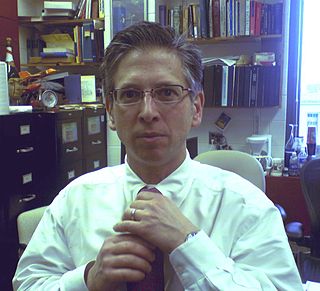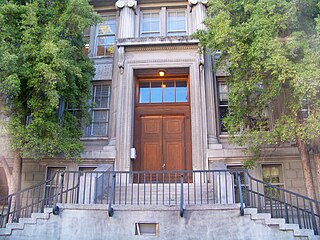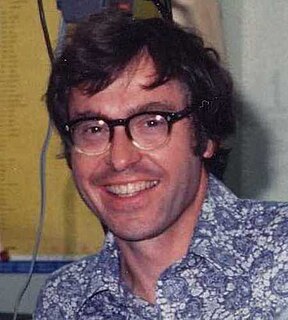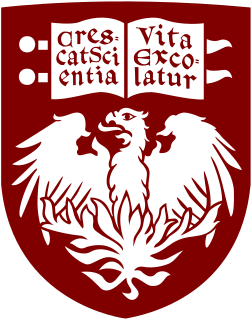
Melvin Ellis Calvin was an American biochemist most famed for discovering the Calvin cycle along with Andrew Benson and James Bassham, for which he was awarded the 1961 Nobel Prize in Chemistry. He spent most of his five-decade career at the University of California, Berkeley.

Edward Chace Tolman was an American psychologist. Through Tolman's theories and works, he founded what is now a branch of psychology known as purposive behaviorism. Tolman also promoted the concept known as latent learning first coined by Blodgett (1929). A Review of General Psychology survey, published in 2002, ranked Tolman as the 45th most cited psychologist of the 20th century.
Donald James Cram was an American chemist who shared the 1987 Nobel Prize in Chemistry with Jean-Marie Lehn and Charles J. Pedersen "for their development and use of molecules with structure-specific interactions of high selectivity." They were the founders of the field of host–guest chemistry.

Kenneth Sanborn Pitzer was an American physical and theoretical chemist, educator, and university president. He was described as "one of the most influential physical chemists of his era" whose work "spanned almost all of the important fields of physical chemistry: thermodynamics, statistical mechanics, molecular structure, quantum mechanics, spectroscopy, chemical bonding, relativistic chemical effects, properties of concentrated aqueous salt solutions, kinetics, and conformational analysis."

Gabor A. Somorjai is a professor of chemistry at the University of California, Berkeley, and is a leading researcher in the field of surface chemistry and catalysis, especially the catalytic effects of metal surfaces. For his contributions to the field, Somorjai won the Wolf Prize in Chemistry in 1998, the Linus Pauling Award in 2000, the National Medal of Science in 2002, the Priestley Medal in 2008, the 2010 BBVA Foundation Frontiers of Knowledge Award in Basic Science and the NAS Award in Chemical Sciences in 2013. Most recently, in April 2015, Somorjai was awarded the American Chemical Society's William H. Nichols Medal Award.

Paul S. Weiss is a leading American nanoscientist at the University of California, Los Angeles. He holds numerous positions, including UC Presidential Chair, Distinguished Professor of Chemistry and Biochemistry and of Materials Science and Engineering, and founder and editor-in-chief of ACS Nano. From 2009–2014 he held the Fred Kavli Chair in NanoSystems Sciences and was the director of the California NanoSystems Institute. Weiss has co-authored over 300 research publications and US and international patents.

The University of California, Berkeley Graduate School of Education is one of 14 schools and colleges at the University of California, Berkeley, and has historically been one of the top schools of education in the United States. The Graduate School of Education specializes in teacher training and education research.

Henry Rapoport was an internationally renowned organic chemist and Professor of Chemistry at the University of California, Berkeley. He is widely recognized for his work in the development of the chemical synthesis of biologically important compounds and pharmaceuticals.

Steven Dale Ittel is an American chemist specializing in organometallic chemistry and homogeneous catalysis.

Gilman Hall is a building on the campus of the University of California, Berkeley. Room 307 was where Glenn T. Seaborg and his coworkers identified plutonium as a new element on February 23, 1941 and as such, is designated a National Historic Landmark. The building itself is designated a National Historic Chemical Landmark, recognizing the two Nobel Prizes in Chemistry that have resulted from research done in the building.
David Chandler was a physical chemist and a professor at the University of California, Berkeley. He was a member of the United States National Academy of Sciences and a winner of the Irving Langmuir Award. He published two books and over 300 scientific articles.
Arthur Wilson Adamson (1919–2003) was an American chemist who is considered a pioneer in inorganic photochemistry. His research made significant contributions to the understanding of physical adsorption and contact angle phenomena, and the thermodynamics of surfaces and irreversible adsorption.
Thomas C. Bruice is a professor of chemistry and biochemistry at University of California, Santa Barbara. He was elected to the National Academy of Sciences in 1974. He is a pioneering researcher in the area of chemical biology, and is one of the 50 most cited chemists.
Richard B. Kaner is a synthetic inorganic chemist, whose work spans across many areas of expertise. He is well known for his research in the fields of conductive polymers (polyaniline), superhard materials and carbon compounds, such as fullerenes and graphene. Richard Kaner holds a joint appointment in the Department of Chemistry and Biochemistry as well as the Department of Material Science and Engineering at UCLA.

Chadwick A. Tolman is an American chemist. He obtained his B.S. in Chemistry from Massachusetts Institute of Technology. He earned his Ph.D. in Chemistry as a microwave spectroscopist from U.C. Berkeley under the guidance of Professor William Gwinn.
David Krech was a Polish -born American experimental and social psychologist who lectured predominately at the University of California, Berkeley. Throughout his education and career endeavors, Krech was with many psychologists including Edward Tolman, Karl Lashley, and Rensis Likert.

George Malcolm Stratton was an American psychologist who pioneered the study of perception in vision by wearing special glasses which inverted images up and down and left and right. He studied under one of the founders of modern psychology, Wilhelm Wundt, and started one of the first experimental psychology labs in America, at the University of California, Berkeley. Stratton's studies on binocular vision inspired many later studies on the subject. He was one of the initial members of the philosophy department at Berkeley, and the first chair of its psychology department. He also worked on sociology, focusing on international relations and peace. Stratton presided over the American Psychological Association in 1908, and was a member of the National Academy of Sciences. He wrote a book on experimental psychology and its methods and scope; published articles on the studies at his labs on perception, and on reviews of studies in the field; served on several psychological committees during and after World War I; and served as advisor to doctoral students who would go on to head psychology departments.
Oliver Reynolds Wulf was a chemist, physicist, and meteorologist, known for his research on nitrogen fixation, ozone, atmospheric dynamics, and ions and winds in the ionosphere.

John D. Baldeschwieler is an American chemist who has made significant contributions in Molecular Structure and Spectroscopy.














